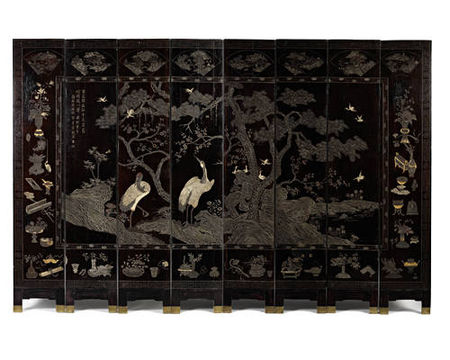A Ming Emperor's Carpet and Other Imperial Artefacts @ Bonhams
For discriminating Chinese art collectors, Bonhams sale of fine Chinese Art on November 10th in London provides a rare opportunity to acquire objects made for the Chinese Imperial Court and the Emperor.
The sale offers a stunning array of ceramics, jade, bronzes, furniture and one particularly fascinating carpet which has links to the Imperial Ming throne room in the Forbidden City. The carpet, a subtle work of art in muted yellows and blues, features a five-clawed dragon, symbol of the Emperor. It is estimated to sell for £80,000 to £120,000.
An extremely rare yellow-ground 'dragon' carpet dating from the late Ming Dynasty, it features a ferocious full-faced five-clawed dragon and measures approximately 17ft by 10ft.
Carpets of this age and form are exceptionally rare. From Imperial records and from inscriptions on carpets themselves we know that carpets were designed specifically for certain halls within the imperial palaces, as an integral part of the architecture of the building. The trapezoidal shape and key-fret border of the present lot suggests that it was intended to be placed around a central octagonal carpet on which the throne platform was placed.
The design of the bold front-facing five-clawed dragon is typical of the Ming period. The colour scheme is also reflected in the wucai palette used on porcelains which reached its peak during the Wanli period. The five-clawed dragon again suggests an Imperial use for the carpet, since it is associated with the person of the emperor, and is frequently used on other textiles such as Imperial silk robes.
These Imperial associations and the use of such carpets in very particular settings accounts for their rarity in the past, since such carpets were produced in very limited numbers and passed down as part of the inheritance from emperor to emperor; the lot presently offered for sale is even more rare today.
Asaph Hyman, senior specialist in Chinese Art at Bonhams, comments: "Fuelled by demand from China, artefacts of this quality are defying the current economic trends. The historical connection between China and Britain and the ongoing links through the art market all add up to a most encouraging outlook for Chinese art."
A rare documentary eight-leaf carved lacquer screen. Kangxi cyclical date jiawu corresponding to AD1714 and of the period. Photo Bonhams
Complimenting the wonderful Imperial carpet is a rare documentary eight-leaf carved lacquer screen from the Kangxi period AD 1714, estimated to sell for £60,000 to £80,000. The screen in brown and gold shows a single scene of a dignitary in his hall entertained by two dancing ladies and surrounded by female attendants, set on a gold-ground terrace with further figures and two cranes, flanked by two smaller dwellings with scholars playing chess, all within a wide border with scholarly vessels on three sides and exotic animals at the bottom, the reverse carved with two large cranes painted in white and red, amidst pines, prunus and rockwork.
An inscription contains the following couplet from a poem by the Tang Dynasty poet Xu Hun (circa AD790 - circa AD858) which can be translated as: 'Amongst the hundred blooming flowers stands the pine tree a thousand feet high; Amongst all the chattering birds the crane makes a clear sound.'
The screen thus uses both painting and poetry elegantly to illustrate the concept of the dignitary as a towering figure and clear voice of authority at his own court. A further link to Tang history can be seen in the hall named on the screen as Fen yang wang fu, which refers to the hall given by the grateful Tang Emperor Xuanzong (685-762) to his general Guo Ziyi (697-781) after he pacified a rebellion. This story became a well-known source of pride for the Guo family, and it is interesting to note that this screen itself carries a dedication by a member of this family, Guo Bingzhang.

/https%3A%2F%2Fprofilepics.canalblog.com%2Fprofilepics%2F1%2F0%2F100183.jpg)
/https%3A%2F%2Fstorage.canalblog.com%2F03%2F02%2F119589%2F96711876_o.jpg)
/https%3A%2F%2Fstorage.canalblog.com%2F11%2F31%2F119589%2F94773502_o.jpg)
/https%3A%2F%2Fstorage.canalblog.com%2F20%2F83%2F119589%2F94772815_o.jpg)
/https%3A%2F%2Fstorage.canalblog.com%2F26%2F72%2F119589%2F75604929_o.jpg)
/https%3A%2F%2Fstorage.canalblog.com%2F59%2F60%2F119589%2F26458628_o.jpg)





/http%3A%2F%2Fstorage.canalblog.com%2F79%2F84%2F119589%2F121121505_o.png)
/http%3A%2F%2Fstorage.canalblog.com%2F80%2F42%2F119589%2F120611565_o.jpg)
/http%3A%2F%2Fstorage.canalblog.com%2F79%2F49%2F119589%2F113206128_o.jpg)
/http%3A%2F%2Fstorage.canalblog.com%2F80%2F78%2F119589%2F113206111_o.jpg)